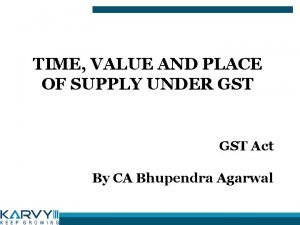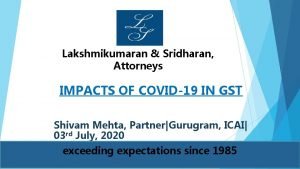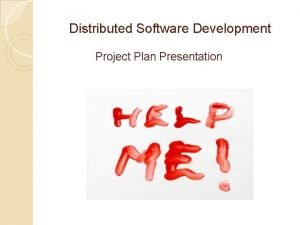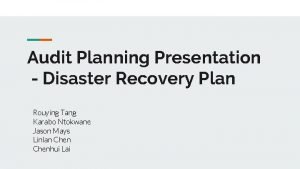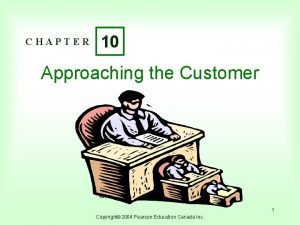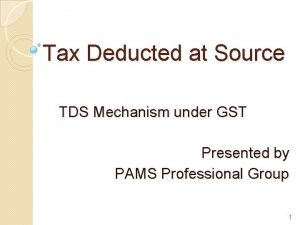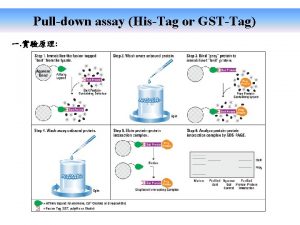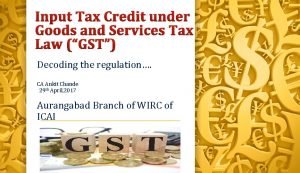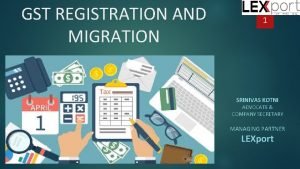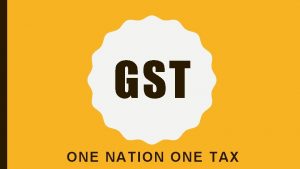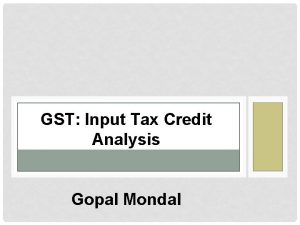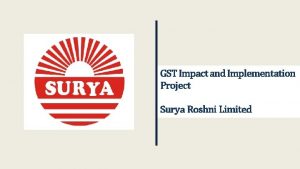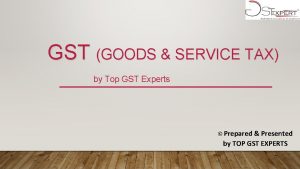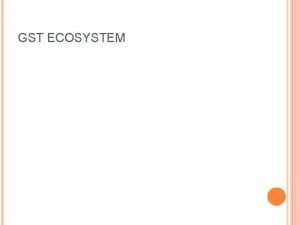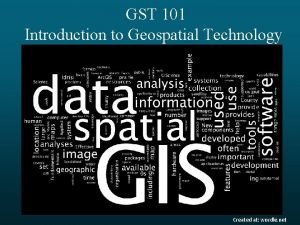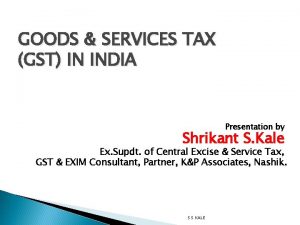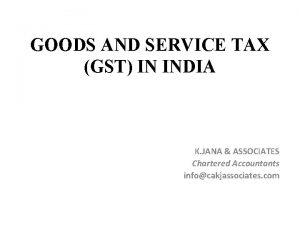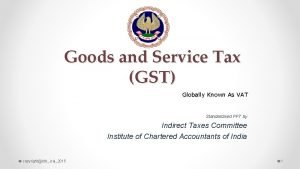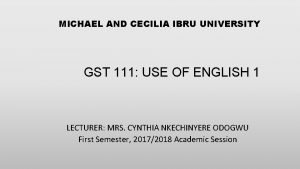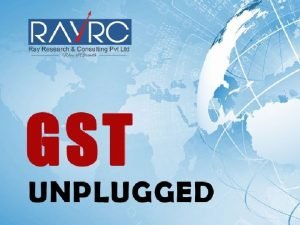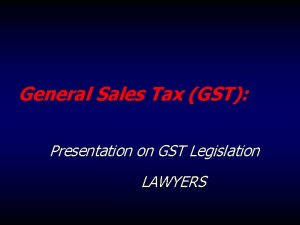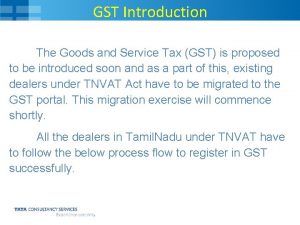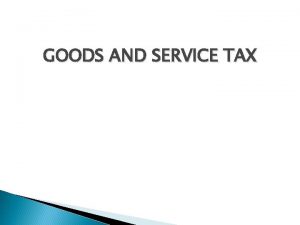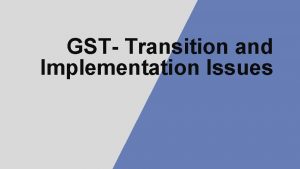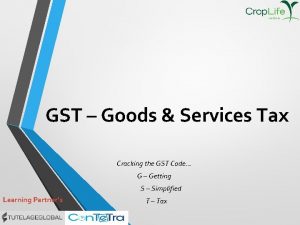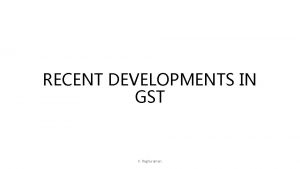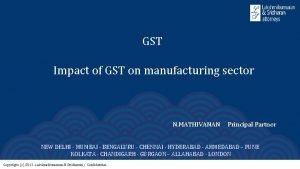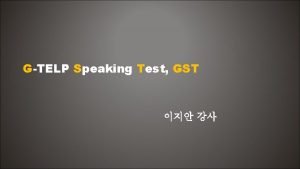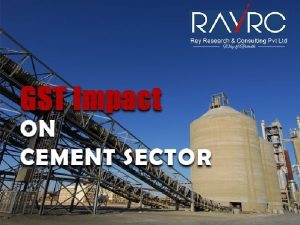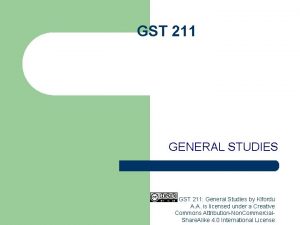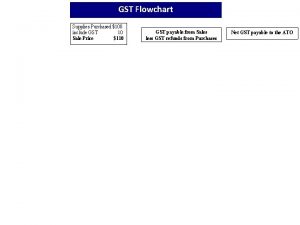GST PRESENTATION PLAN What is GST and GST








































- Slides: 40

GST

PRESENTATION PLAN • What is GST and GST Framework • Basics about GST Levy • Fundamental GST Concepts • How GST Works & Actions for readiness • GST Rates for Goods/Services • Implementation of GST • GST Update • GST & Make in India • Anti Profiteering Rule • GST Vision 2020 • Conclusion 2

WHAT IS GST • GST is a destination based tax on consumption of goods and services i. e. state where goods were consumed will collect GST; • It is levied at all stages right from manufacture up to final consumption; • Elimination of cascading effect in indirect taxes; • Automated reporting and compliance • CGST and SGST levied simultaneously on supply of goods / services valued at the same price 3

GST FRAMEWORK • Center and State to charge GST on common base • Integrated GST (IGST) on inter state supply of goods/services • Minimum exemptions currently • 7 rates of tax: Nil, 3%, 5%, 12%, 18%, 28% and 28%+Cess for goods/services 4

BASICS ABOUT GST LEVY GST Charged On GST Liability On Time and Place of Tax • Supply of Goods and Services except alcoholic liquor for human consumption and specified petroleum products (Diesel, Petrol, CNG) • Person supplying goods/services (Supplier) • Recipient of goods/services in certain cases • Time of Supply to determine when tax liability accrues • Place of supply will be the basis for deciding the levy of CGST + SGST (for intra state supply) or IGST (for inter state supply). 5

TAXES TO BE SUBSUMED IN GST x ta e ic rv Se C D en Ex uty tra ci + l E se A x d d cis ut di e* ie tio s n al State cesses & surcharges on goods & services al on s l & iti m na dd sto tio l A u di ia f C Ad ec o Sp uty D C su en go rc tra od ha l c s rg es & es se s o s er n & vi ce s Central Taxes on lottery, betting, gambling VAT State Central Sales Tax Purchase Tax & Luxury Tax Entry Tax & Octroi Entertainment Tax (except by local bodies) Note: 1) Alcoholic beverages for human consumption are proposed to be kept out of the purview of GST 2) GST on petroleum crude, high speed diesel, motor spirit and aviation turbine fuel shall be levied with effect from a notified date recommended by the GST Council 6 3) GST Council amidst discussions on including natural gas with a GST rate of 5% 4) * Includes Excise duty levied under Medicinal & Toilet Preparations (Excise Duties) Act, 1955

FUNDAMENTAL GST CONCEPTS 7

Goods • Every kind of movable property other than money and securities; • includes actionable claim, growing crops, grass and things attached to or forming part of the land & agreed to be severed before supply or under a contract of supply • anything other than goods, money and securities; Services • includes an activity relating to use of money or conversion from one currency to another for which a separate consideration is charged 8

Supply Includes: Sale, transfer, barter, exchange, license, rental, lease or disposal for a consideration in the course or furtherance of business Import of service, whether or not for a consideration Supply specified in Schedule I made or agreed to be made without consideration. Schedule I includes the following – (i) Any supply between two related persons (ii) Any supply between two different registered units of the same legal entity. 9

Who is a taxable Person ? A person who is liable to be registered under the GST Act. (Turnover exceeding Rs. 20 lacs, and 10 lacs for special states) Separate GST registration for each state Only one GST registration in a state (option to avail multiple registration only in case taxable person as separate business verticals) 2 separate GST registrations of a legal entity would be considered as “distinct taxable person” for the purposes of GST levy 10

GST PAYMENTS GOODS SUPPLIED OR SERVICES PROVIDED WITHIN UNION TERRITORY CGST* UTGST** INTRA STATE CGST INTER STATE SGST◦ *Central GST **Union Territory GST ◦State GST ºIntegrated GST IGSTº 11

CREDIT UTILIZATION CGST SGST IGST CGST SGST 12

Composition Scheme Non Eligibility Conditions Aggregate Turnover <= 75 Lakhs Supply of goods not liable to tax Tax not collected from recipient Supply of Services except Restaurants of Supply Inter State supply of goods Input Tax credit not availed Supply of goods through E Commerce Manufacture of goods notified by Govt. Rate of Tax In Case Of: Rate Not Exceeding: Manufactures 2% of Turnover of State/Union Territory Restaurants/Eating Joints 5% of Turnover of State/Union Territory Other Suppliers 1% of Turnover of State/Union Territory 13

GST Returns Monthly Returns Normal Assessee Outward Details: GSTR-1(10 th of the next month) GSTR-1 A (15 th to 17 th of next month) Inward Details: GSTR-2 (11 th to 15 th of next month) Annual Returns Assessee under Composition Levy Normal Assessee Quarterly Return Within 18 th of the month following the quarter GSTR-4 (31 st Dec of Next F. Y. ) Return (with tax): GSTR-3 (20 th of next month) GSTR-9 Assessee under Composition Levy GSTR-9 A (31 st Dec of Next F. Y. ) 14

HOW GST WORKS 15

ACTIONS FOR GST READINESS • Transition Planning • Information Technology Systems (ERPs) adaptability to GST • Pricing policy • Focus on business network partnership • Cross functional training 16

GST RATES FOR GOODS/SERVICES

PERCENTAGE SPREAD OF GOODS & SERVICES ACROSS VARIOUS GST RATES 18

Essential Food Articles After GST Essential items will attract 0% tax and hence lead to a decrease in grocery bills Before GST 32% 33% 28% 18% 5% 5% 0% 0% Cereals, rice, Sugar, Tea, Biscuits, Corn wheat, pulses, Coffee, Edible Flakes, Ice milk Oil Cream Chocolates 19

24% 30% 28% 18% 12% 5% 5% 5% Ayurvedic Footware> Products Rs. 500 12% 18% 5% Footware>Rs. 500 39% Cotton Ayurvedic Products 24% Silk & Jute Soap & Shampoo Silk & Jute Hair Oil & Face Cream 18% 28% 0% 5% 5% Cotton 0% hampoo & Face Cream GST 39% oap & Hair Oil GST FMCG 30% 20

Durable Items After GST 28% Before GST 28% 31% 23% 17% 12% 3% 2% TV, AC, Fridge, Washing Machine, Furniture Gold Smartphones Cement Cost of TV, Fridge, Washing machines will increase, cost of smart phones will reduce and cost of Gold will increase 21

Basic Services After GST Before GST 40% 28% 18% 15% 15% 12% 5% 6% Insurance Banking Mobile Bills Premium Charges Movie Tickets 9% Cab Rides Air Travel (OLA, (Business UBER) Class) 22

EXEMPT GOODS/SERVICES • Fresh meat, fish, chicken, eggs, milk, buttermilk, curd, natural honey, fresh fruits and vegetables • Flour, bread, salt, Bindi, Sindoor, bangles • Stamps, judicial papers, printed books, newspapers, bangles, handloom, jute • Train travel by local and sleeper class • Education and Healthcare (excluding medicines) • Hotels & lodges with Room rent below Rs. 1000 23

IMPLEMENTATION 24

GST IMPLEMENTATION (JULY & AUGUST 17) • GST implemented w. e. f. July 1, 2017 • Relaxation in return filing procedure for first two months i. e. July & August 2017 is provided for • Tax payable based on simple return (Form GSTR 3 B) containing summary of outward and inward supplies • GSTR 3 B to be submitted before 20 th of the succeeding month 25

GST IMPLEMENTATION (JULY & AUGUST 17) Invoice wise details to be filed as under: Month GSTR-3 B GSTR -1 GSTR – 2 GSTR - 3 (autopopulated from GSTR-1) July, 2017 20 th August 1 st – 5 th September 6 th – 10 th September 11 th 15 th September August, 2017 20 th 16 th 20 th September 21 st 25 th September 26 th 30 th September 26

GST UPDATE • The GST Council held its 20 th meeting on 5 th August, 2017 wherein it appealed to the Indian industry to pass on the input credit to customers • E way bill system would be rolled out from October 1 • The job work rate for all kinds of work in the textile chain has been kept at 5% • Works contract under GST will be taxed at 12% with ITC 27

GST UPDATE (CONTD…) • 71 lakh central and state taxpayers have migrated to the GST system. Another 15. 67 lakh new applications for registration have been received • The National Anti profiteering Authority has been proposed a three tier structure including a committee at the state level to deal with local complaints • The next meeting of the GST Council will be held at Hyderabad on September 9, 2017 28

GST & MAKE IN INDIA 29

• It is expected that the total incidence of duty on manufacturing (goods) will come down from the present level of 26. 5 per cent (Centre: 14 per cent plus State VAT: 12. 5 per cent) • It will create a level playing field between imports and domestic manufacturing • Concurrent taxation by the Centre and the states on the same taxable base from raw material to retail will facilitate better compliance verification leading to equality in domestic manufacturing and trading. 30

• Lower threshold limits for manufacturing under GST will prevent fragmentation of units. • The slogan of Make in India by "Making One India" coined by Mr. Arvind Subramanian, the Chief Economic Advisor, in his GST report is apt. • Eliminating checkpoints and other entry barriers would facilitate faster movement of goods as roads are still the preferred mode of transportation in India. Industry can therefore keep inventory costs low by keeping inventory levels down. Further, it will also have a positive impact on the environment. • Expansion of the market itself due to lowering of inter state barriers. 31

ANTI PROFITEERING RULE 32

• The government's aim behind bringing the anti profiteering rule was to primarily reign the possibility of inflation after GST rolls out, but the hastily drafted rules have proved to be contentious and may even be unconstitutional • Section 171 of the CGST Act creates the obligation on businesses to pass on to the recipients any reduction in the rate of tax or the benefit of input tax credit by way of a commensurate reduction in prices. However, there is hardly any guidance for what is commensurate reduction. • The only saving grace of this rule is that the government has inserted a sunset clause (of 2 years) in the GST law 33

• The rules prescribe an administrative framework for administering anti profiteering and stringent punishments, but no guidance on what will constitute 'profiteering‘ • There is no specific talk of any penalty in the rules and hence will be on a wholly discretionary basis, which can be as draconian as cancellation of registration • Businesses need to recognize that even in the absence of publication of rules etc. , the obligation on them would, arise on the day the GST Act takes effect. 34

GST VISION 2020 35

• Single Registration for supply of goods/services in all states across India • No more than three tax rates, down from the existing seven, implemented over a period of 3 5 years as follows: Ø Exempt Ø 16% general goods/services rate Ø 28% rate for goods/services for sin all and other luxury • No separates for inbound and out bound goods 36

• Voluntary reverse charge mechanism • Manufacturer + Service Provider to be subject to a single charge on both goods and services • Tax to GDP Ratio @ 22% of a $3 trillion economy • More than 50% of State Governments at surplus/zero deficit • Overall Fiscal deficit at 1. 75% • No Exemption, No Composition • Marketization, Formalization, Compliance for a Secular Growth Path • GDP at an all time high of 10% 37

CONCLUSION 38

• Change is definitely never easy. It is important to take a leaf from global economies that implemented GST and overcame the teething troubles to experience the advantages of having a unified tax system, easy input credits, and reduced compliances. • Once GST is implemented, most of the current challenges of this move will be a story of the past. India will become a single market where goods can move freely and there will lesser compliances to deal with for businesses. 39

THANK YOU 40
 Brow presentation birth
Brow presentation birth Cephalic presentation
Cephalic presentation Philosophy and human existence gst 113
Philosophy and human existence gst 113 Time and value of supply under gst
Time and value of supply under gst Gst168
Gst168 Career plan presentation example
Career plan presentation example Social media training plan presentation
Social media training plan presentation Software development project plan
Software development project plan Business continuity plan presentation
Business continuity plan presentation Presentation plan in business communication
Presentation plan in business communication Employee engagement survey results and action plan ppt
Employee engagement survey results and action plan ppt Network 21 australia
Network 21 australia Disaster recovery plan presentation
Disaster recovery plan presentation Six step presentation plan
Six step presentation plan Operational plan presentation
Operational plan presentation Answer site
Answer site Short medium and long term planning in education
Short medium and long term planning in education Micro teach lesson plan example
Micro teach lesson plan example Contoh tata letak perusahaan jasa
Contoh tata letak perusahaan jasa Virginia plan and new jersey plan venn diagram
Virginia plan and new jersey plan venn diagram What is utr in gst
What is utr in gst Gst deduction at source
Gst deduction at source Annexure b for gst refund
Annexure b for gst refund Gst pulldown assay
Gst pulldown assay Gst 105 use of english pdf
Gst 105 use of english pdf Section 18(1)(c) of gst
Section 18(1)(c) of gst Srinivas kotni
Srinivas kotni Introduction of gst
Introduction of gst Section 18(1)(c) of gst
Section 18(1)(c) of gst Surya roshni share
Surya roshni share Gst rates on services pdf
Gst rates on services pdf Roles in gst eco system
Roles in gst eco system Gst 101
Gst 101 Before gst tax structure in india
Before gst tax structure in india Concept of gst
Concept of gst Goods and service tax
Goods and service tax E-way bill login id password
E-way bill login id password Michael and cecilia ibru university
Michael and cecilia ibru university Impact of gst on construction industry
Impact of gst on construction industry Conclusion on gst
Conclusion on gst Gst matchup chart
Gst matchup chart



